Community College Participants and Projects: 2019
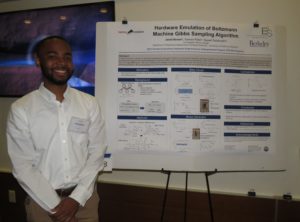 Undergraduate Researcher: Jared Brown
Undergraduate Researcher: Jared Brown
Intended Major: Mechanical Engineering
Home Institution: Los Angeles Pierce College
Research Project: Hardware Emulation of Boltzmann Machine Gibbs Sampling Algorithm
Faculty Advisor: Prof. Sayeef Salahuddin
Graduate Student Mentor: Saavan Patel
UC Berkeley Department: Department of Electrical Engineering and Computer Science
Project Abstract: In order to arrive at a solution for NP-Hard combinatorial optimization problems, we have turned towards a dedicated hardware model. We utilized a machine learning-based algorithm that is governed by the stochastic formulations of the Restricted Boltzmann Machine (RBM), a type of neural network and probabilistic model. We then developed a circuit that imitates the RBM’s Gibbs Sampling algorithm in the form of a single RBM neuron. This circuit outputs digital voltages in order to communicate results. This circuit board is a large-scale model of how an integrated circuit (IC), or a chip functions within modern technological devices. By constructing this circuit, we demonstrate that the hardware model can not only emulate the algorithm’s behavior but also that of an integrated circuit. Project poster
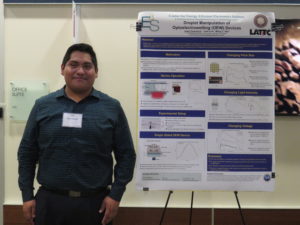 Undergraduate Researcher: Jose Camacho
Undergraduate Researcher: Jose Camacho
Intended Major: Electrical Engineering
Home Institution: Los Angeles Trade Technical College
Research Project: Droplet Manipulation of the Two-Plated and Single-Sided Optoelectrical Wetting Devices
Faculty Advisor: Prof. Ming C. Wu
Graduate Student Mentor: Jodi Loo
UC Berkeley Department: Department of Electrical Engineering and Computer Science
Project Abstract: Microfluidics, the science of manipulating small volumes (pL to uL) of liquids, benefits from the ability to perform large numbers of chemical and biological reactions in parallel. Digital microfluidics, compared to continuous-flow based microfluidics, benefits from individual sample addressing. We are developing a Light-Actuated Digital Microfluidics device based on the principle of Optoelectrowetting (OEW). Our device posses many advantages including real-time reconfigurable large-scale droplet control using low-intensity light sources. Project poster
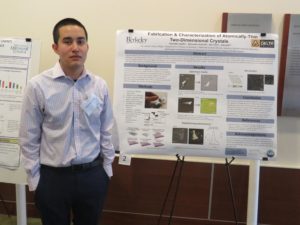 Undergraduate Researcher: Alex Castillo
Undergraduate Researcher: Alex Castillo
Intended Major: Mechanical Engineering
Home Institution: San Joaquin Delta College
Research Project: Fabrication & Characterization of Atomically-Thin Two-Dimensional Crystals
Faculty Advisor: Prof. Alex Zettl
Postdoctoral Mentor: Dr. Amin Azizi
UC Berkeley Department: Department of Physics
Project Abstract: Two-dimensional (2D) materials, like h-BN and graphene, offer an array of unique characteristics and electrical properties. These properties can vary in degree depending on the number of layers that compose each substance. The characteristics of various 2D materials with different layer numbers will be analyzed. Using the mechanical exfoliation method, mono- and few-layer flakes can be produced from bulk crystals with the use of adhesive tape. Once these flakes are produced, they can be transferred onto substrates like SiO2 or quartz. The mono- and few-layer flakes can then be identified with the use of an optical microscope. After ideal flakes have been identified, their characteristics will be tested. Project poster
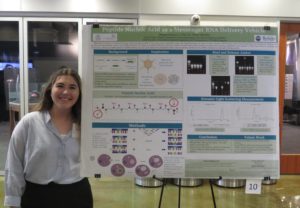 Undergraduate Researcher: Megan Garcia
Undergraduate Researcher: Megan Garcia
Intended Major: Microbiology
Home Institution: Irvine Valley College
Research Project: Peptide Nucleic Acid as a Messenger RNA Delivery Vehicle
Faculty Advisor: Prof. Niren Murthy
Postdoctoral Mentor: Dr. I-Che Li
UC Berkeley Department: Department of Bioengineering
Project Abstract: Innovation in medicine has been growing exponentially in the recent years, especially in the area of gene therapy. An area of major interest is DNA-based nucleic acid therapeutics and vehicles for delivery. Here we demonstrate peptide nucleic acids (PNA) potential for being a successful delivery vehicle for mRNA through testing the structure’s binding and releasing capabilities. Our interest in PNA stems from its neutrality and nontoxicity, making it a stable option for mRNA delivery into cells. This experiment establishes PNA’s use as a delivery vehicle for any mRNA, making it a viable gene therapy option. Project poster
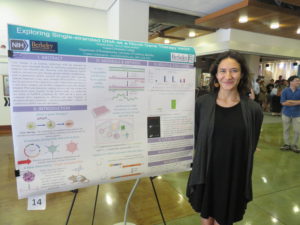
Undergraduate Researcher: Victoria Helm
Intended Major: Neurobiology and Cognitive Science
Home Institution: Cuesta College
Research Project: Exploring Single-stranded DNA as a Novel Gene Therapy Vector
Faculty Advisor: Prof. Niren Murthy
Postdoctoral Mentor: Dr. Jie Li
UC Berkeley Department: Department of Bioengineering
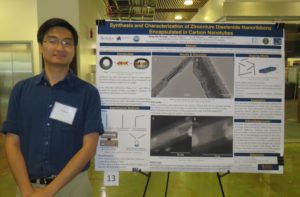 Undergraduate Researcher: Tony Vo Hoang
Undergraduate Researcher: Tony Vo Hoang
Intended Major: Chemistry
Home Institution: Cosumnes River College
Research Project: Synthesis of Zirconium Diselenide Nanoribbons Encapsulated in Carbon Nanotubes
Faculty Advisor: Prof. Alex Zettl
Graduate Student Mentor: Derek Popple
UC Berkeley Department: Department of Chemistry and Department of Physics
Project Abstract: Two-dimensional (2D) materials such as graphene and the transition metal dichalcogenides (TMDs) display vastly different properties and potential applications once exfoliated from their bulk counterpart. The properties of these 2D materials can be further modulated by confining the materials into quasi-one-dimensional (1D) nanoribbons. However, the synthesis of nanoribbons is challenging due to the difficulty of confining the growth to a single dimension. One solution to this challenge is to use carbon nanotubes (CNT) to template the growth of 1D materials through geometric confinement. Here, we report the growth of quasi-1D zirconium diselenide (ZrSe2) nanoribbons inside CNTs using chemical vapor transport. The filling of ZrSe2 nanoribbons within multi-wall CNTs was confirmed via transmission electron microscopy (TEM) and scanning transmission electron microscopy (STEM). This demonstration of templated growth of ZrSe2 may provide a generalized platform for the bottom-up synthesis of other TMD nanoribbons Project poster
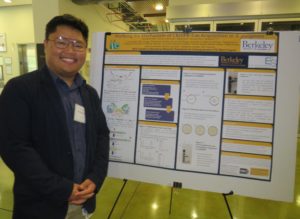
Undergraduate Researcher: Ted Daniel Llera
Intended Major: Molecular and Cell Biology: Immunology and Pathogenesis
Home Institution: Los Angeles Valley College
Research Project: Studying the Mechanism of CRISPR-Cas Acquisition in S. pyogenes
Faculty Advisor: Prof. Jennifer A. Doudna
Postdoctoral: Dr. Shrutee Jakhanwal
UC Berkeley Department: Department of Molecular and Cell Biology
Abstract: In bacteria and archaea, clustered regularly interspaced short palindromic repeat (CRISPR) provide adaptive immunity against viral infection. Universally conserved CRISPR associated (Cas) proteins, such as Cas1 and Cas2, have the ability to acquire foreign DNA into the CRISPR locus as a new spacer. The CRISPR immunity starts with adaptation, followed by the biogenesis of crRNA, which in turn complexes with Cas9 to form the effector complex. In this study, we have tried to develop a screen for studying the site, sequences and orientation of the integrated protospacers in S. pyogenes. By developing such a screen, it would create a platform to fully understand the precision of integration in S. pyogenes. Project poster
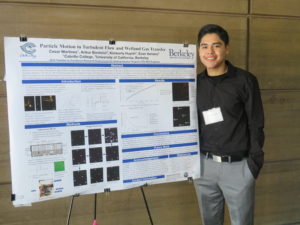 Undergraduate Researcher: Cesar Martinez
Undergraduate Researcher: Cesar Martinez
Intended Major: Mechanical Engineering
Home Institution: Cabrillo College
Research Project: Particle Motion in Turbulent Flow and Wetland Gas Transfer
Faculty Advisor: Prof. Evan Variano
Graduate Student Mentor: Ankur Bordoloi
UC Berkeley Department: Department of Civil and Environmental Engineering
Project Abstract: Oceanic turbulence directly influences the transport of marine particles such as debris or organisms, which impact the ecosystem. This research aims to understand the physics of particle motion in turbulent fluids in a laboratory environment. We perform experiments to explore the relationship between fluid flows and particle dynamics. Specifically, we record the kinematic response of fluorescent green polyethylene microspheres with diameters between 125-150 μm. We did this by using custom-designed cameras, and tracking their motions to examine fluid flows in a simulated wetland. The primary goal is to process images to determine the velocity of these microparticles passively following the fluid motions. We characterize the fluid turbulence using the resolved motions of these passive particles. This characterization is used to understand mixing, which leads to a better idea of what happens to particles as they travel and how they interact amongst each other. This allows us to better comprehend the locomotion, feeding, colonizing, and escape mechanisms of marine organisms. Project Poster
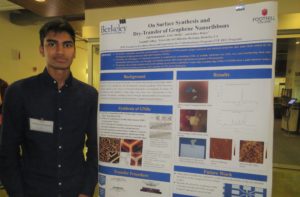
Undergraduate Researcher: Saifuddin Mohammed
Intended Major: Electrical Engineering and Computer Science
Home Institution: Foothill College
Research Project: On Surface Synthesis and Dry-transfer of Graphene Nanoribbons for High Performance Field-Effect Transistors
Faculty Advisor: Prof. Jeffrey Bokor
Postdoctoral Mentor: Dr. Zafer Mutlu
UC Berkeley Department: Department of Electrical Engineering and Computer Science
Project Abstract: On surface synthesized atomically precise graphene nanoribbons (GNRs) possess unique structural and electrical properties that make them critical for the development of high-performance field-effect transistors (FETs). Currently, the fabrication of GNR-based transistors is conducted by synthesizing GNRs on metallic substrates (Au (111), etc.) and transferring them onto non-metallic substrates (SiO2, etc.) through a wet-transfer method. However, this process involves the use of solvents and strong acids which often results in the degradation of intrinsic GNR properties. Herein, we present a dry-transfer method which involves picking up on-surface synthesized 7-atom wide armchair-edge GNRs (7-aGNRs) from a gold substrate using a film of Polypropylene Carbonate (PPC) and stamping them onto a SiO2 substrate for FET device fabrication. Using Raman spectroscopy, atomic force microscopy, and scanning tunneling microscopy, we identify and characterize the GNRs before and after the transfer process to ensure high structural and electrical homogeneity. The dry-transferred GNRs are expected to exhibit excellent electron transport characteristics and are therefore potentially ideal for use as the channel material in post-silicon Complementary Metal Oxide Semiconductor (CMOS) transistors, enabling the ultimate scaling of high performance digital electronics. Project poster
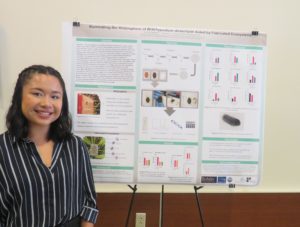 Undergraduate Researcher: Christal Nevarez
Undergraduate Researcher: Christal Nevarez
Intended Major: Environmental Engineering
Home Institution: Skyline College
Research Project: Illuminating the Rhizosphere of Brachypodiumdistachyon Aided by Fabricated Ecosystems
Faculty Advisor: Dr. Romy Chakraborty
Postdoctoral Mentor: Dr. Nameera Baig
UC Berkeley Department: Lawrence Berkeley Lab: Ecology Department
Project Abstract: The rhizosphere is a highly complex and dynamic region where plant roots interact with microbial communities in the soil. Several factors such as plant organic matter and the inherent chemical properties of the soil play a crucial role in influencing plant growth and shaping the rhizosphere. Studying the rhizosphere is crucial for illuminating carbon cycling and design strategies for promoting plant growth as well as sustainable agricultural practices. The objective of this research project was to employ ion chromatography (IC), biomass analysis, DNA extraction and 16s sequencing to characterize soil chemistry and the microbial biomass in the rhizosphere. We used mesofluidicdevices called EcoFABs(fabricated ecosystems) to grow model grass Brachypodiumdistachyonin a highly reproducible laboratory setting over the course of two weeks in three different types of solid substrates namely, a rich agricultural soil, a marginal soil and sterile quartz sand. We measured the plant biomass and the biochemical properties of the rhizosphere at the end of two weeks. Our results reveal that the measured plant biomass varies based on the type of soil substrate in which the plant grown is grown with relatively higher biomasses observed when the plant is grown in the rich agricultural soil. The findings of this study underscore the complex synergy between soil chemistry, plants andthe soil microbiome in shaping the rhizosphere and affecting plant growth. Project poster
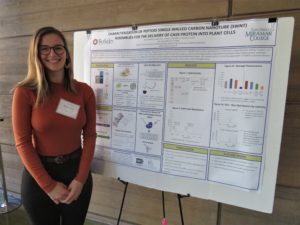 Undergraduate Researcher: Alisa Peshina
Undergraduate Researcher: Alisa Peshina
Intended Major: Bioengineering
Home Institution: San Diego Miramar College
Research Project: Characterization of Peptoid Single-Walled Carbon Nanotube Assemblies for the Delivery of Cas9 Protein
Faculty Advisor: Prof. Markita Landry
Graduate Student Mentors: Linda Chio and Frankie Cunningham
UC Berkeley Department: Department of Chemical and Biomolecular Engineering
Project Abstract: Plant genetic engineering can address several global challenges such as biofuels production, drug discovery, and agricultural development. CRISPR-Cas9 has been developed as a useful tool in target genome editing. In plants, one barrier to CRISPR-Cas9 implementation has been the delivery of Cas9 protein to plant cells, which possess a rigid cell wall. We propose a delivery technology based on peptoid functionalized single-walled carbon nanotubes (SWNTs) conjugated to Cas9 ribonucleoproteins (RNP). Once developed, this system will be tested in vivo via infiltration into Nicotiana benthamiana leaves. Our research aims to reveal the applications of SWNTs in protein delivery for gene editing, with the hopes that this novel technology can be used in plant science and agriculture. Project poster
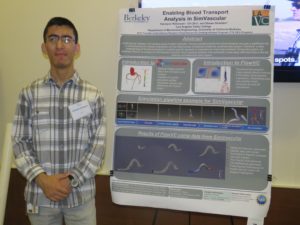 Undergraduate Researcher: Harutyun Rehanyan
Undergraduate Researcher: Harutyun Rehanyan
Intended Major: Computer Science
Home Institution: Los Angeles Valley College
Research Project: Enabling Blood Transport Analysis in SimVascular
Faculty Advisor: Prof. Shawn Shadden
Graduate Student Mentor: Chi Zhu
UC Berkeley Department: Department of Mechanical Engineering
Project Abstract: Cardiovascular disease is the leading cause of death worldwide. Previous studies indicate that blood transport may play a significant role in understanding the disease progression and the effectiveness of treatment inside the cardiovascular system. Therefore, a clear understanding of the blood transport in a patient-specific geometry is imperative for improving treatment. During this project, we integrated FlowVC as a plugin for SimVascular to perform blood transport analysis. We conducted a case study with blood flow in the left ventricle and abdominal aortic system. Project poster
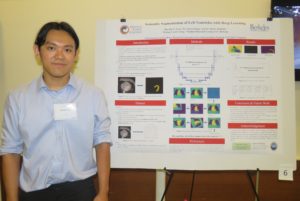
Undergraduate Researcher: Dao Dai Vi Tran
Intended Major: Computer Science
Home Institution: Orange Coast College
Research Project: Semantic Segmentation of Left Ventricles with Deep Learning
Faculty Advisor: Prof. Shawn Shadden
Graduate Student Mentor: Fanwei Kong
UC Berkeley Department: Department of Mechanical Engineering
Project Abstract: Semantic segmentation of cardiac structures is an important task in the development of clinical application. For example, segmentation of left ventricles can contribute in computation of cardiac functional indices, such as ejection fraction. In this research, a left ventricle image dataset was constructed and a fully convolution neural networks (FCN) based on the U-Net architecture was used as a deep learning model to segment left ventricle from medical images. Along with U-Net, we applied a combination of various image processing methods to augment the dataset. The model achieves 93% in terms of Dice score metric and produces a segmentation in millisecond. This result suggests that deep learning model has a very high potential in replacing traditional segmentation methods which require labor-intensive manual intervention. Project poster
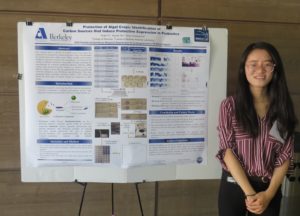
Undergraduate Researcher: Xingli Yu
Intended Major: Chemical Engineering
Home Institution: College of Alameda
Research Project: Identification of Carbon Sources that Induce Protective Expression in Probiotics
Faculty Advisor: Dr. Romy Chakraborty
Postdoctoral Mentor: Dr. Xiaoqin Wu
UC Berkeley Department: Lawrence Berkeley Lab: Ecology Department
Project Abstract: Janthinobacterium is considered one of the most promising probiotics because it can produce an effective protective compound –violacein, which is a hydrophobic purple pigment with antibiotic properties. So far, the ecophysiological regulation of Janthinobacterium especially in the conditions that induce its production of violacein, hasn’t been well studied. This hinders the application of this probiotic. This research aims to identify the carbon sources that induce the expression of violacein by Janthinobacterium. We incubated six Janthinobacterium strains under fifteen variable carbon source conditions, and then measured the concentration of violacein in the cultures at different incubation time points. Through comparing the concentration of violacein production between different carbon sources and Janthinobacterium strains, we identified the most effective carbon sources that can induce both Janthinobacterium biomass growth and violacein production are D-maltose and D-mannitol. The most promising strain to produce violacein is ATCC 12473, which can utilize the most types carbon sources in comparison to other strains. Project poster
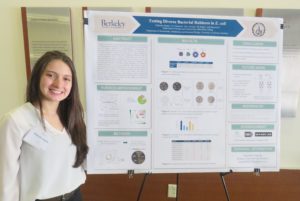
Undergraduate Researcher: Alejandra Zapata
Intended Major: Energy Engineering
Home Institution: Bakersfield College
Research Project: Testing Diverse Bacterial Rubiscos in E. Coli
Faculty Advisor: Prof. David Savage
Postdoctoral Mentor: Dr. Avi Flamholz
UC Berkeley Department: Department of Biochemistry, Biophysics, and Structural Biology
Project Abstract: Rubisco is essential for plant growth and survival. It is responsible for catalyzing carboxylation in the Calvin Cycle which is the primary step of carbon fixation in photosynthesis. Considering the enormous mass of plants on the Earth, Rubisco is categorized as the most abundant enzyme on the planet. In nature, Rubisco is located not only in plants but also in bacteria. Bacteria have four types of Rubisco: Form I, Form II, Form II/III, and Form III [5]. These forms of Rubisco in bacteria make it diverse in size and structure. Researchers theorize that improving Rubisco might improve plant growth. The goal of this research is to test nine different Rubiscos in E.coli and determine their function. Our lab has developed a Rubisco-dependent E. coli that requires functional Rubisco in order to grow. We will test the assembly and function of nine bacterial Rubiscos in this E. coli strain. We also use characterized mutant Rubiscos in this manner. These experiments will provide a basis for understanding the effects of mutations in distinct bacterial Rubiscos which will be useful for researchers aiming to improve plant crops. Project poster